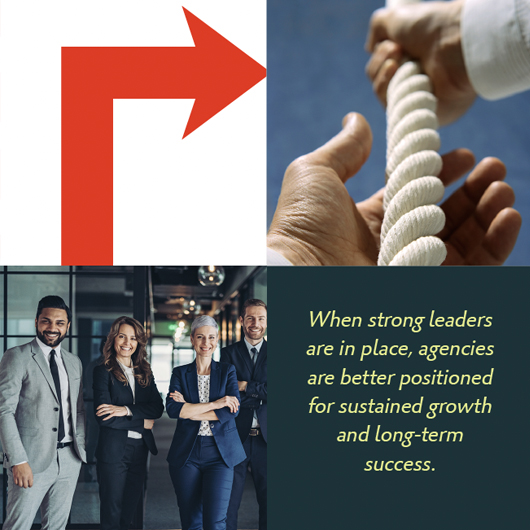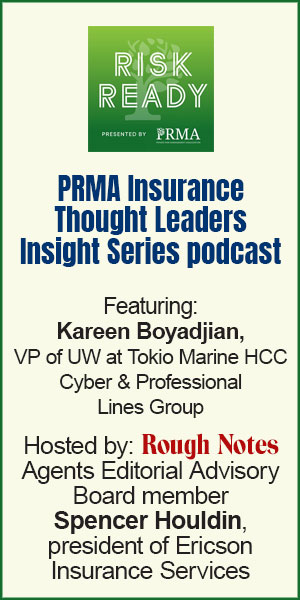
How to build leaders and reap the rewards
By Matt Naimoli
Many insurance agency owners find themselves stuck in dual roles as producers and operational managers. While they may have staff members handling day-to-day tasks, they often lack a true leadership team capable of making key decisions and driving the business forward. This absence of leadership limits the agency’s growth potential, leading many to plateau at revenue levels between $750,000 and $3 million.
Without a leadership team, the agency owner becomes the bottleneck for all critical decisions, stifling innovation, efficiency, and scalability. The daily demands of sales, service, and operations leave little time to focus on strategic planning or business expansion. This often results in exhaustion, missed opportunities, and a lack of business continuity if the owner is unavailable.
To break through these barriers, agency owners must shift their mindset from being the central figure in operations to building a self-sustaining leadership team that empowers others to lead and execute strategic objectives.
Building a leadership team
Successful agency leaders understand that their primary responsibility is to cultivate a strong leadership team capable of managing different aspects of the business. Instead of micromanaging daily operations, they focus on developing a strong culture, fostering key relationships, and casting a clear vision and mission for the agency. They delegate effectively, ensuring that decisions can be made without their direct involvement.
By assembling a competent team, agency owners free themselves to pursue high-impact activities that fuel long-term growth and sustainability. A well-structured leadership team enhances decision-making, increases operational efficiency, and fosters a culture of accountability.

This transformation allows an agency to evolve from a small business into a thriving, scalable enterprise that is no longer solely dependent on the owner’s direct involvement. Additionally, it ensures business continuity, as multiple people are capable of making decisions, keeping operations running smoothly even when the owner is away or focused on high-level growth initiatives.
Step 1: Establish a leadership team. Developing a leadership team begins by identifying key areas of the business that require dedicated leadership. These typically include:
Marketing, branding, and lead generation. A leader who ensures the agency has a steady influx of prospective clients through strategic marketing and brand positioning, this individual must track marketing performance, adjust strategies as needed, and maintain alignment with sales efforts to maximize conversions.
- Sales and business development. A dedicated individual who oversees revenue growth, producer performance, and the execution of sales strategies, this leader ensures that new business goals are met while also improving sales training and development programs for producers.
- Service and client retention. This manager is responsible for policyholder experience, customer satisfaction, and retention initiatives. Retaining clients is just as important as acquiring new ones, and a leader in this role must ensure high-touch client service and proactive problem resolution.
- Operations, human resources, and finance. A leader who manages internal processes, compliance, employee development, financial oversight, and vendor relationships, this individual ensures that the agency remains profitable while also maintaining a high-functioning team through recruitment, training, and retention initiatives.
In smaller agencies, the owner may initially hold multiple roles, but the objective should be to delegate these responsibilities over time as revenue allows for additional hires. Effective delegation enables leadership team members to take ownership of their respective areas, reducing the agency owner’s operational burden and positioning the agency for sustainable growth.
By assigning clear responsibilities and measuring outcomes, leaders can be held accountable for the success of their departments, creating a high-performance culture where every leader is driven to succeed.
Step 2: Organize and implement weekly leadership meetings. A well-structured leadership team needs a clear operational framework. Weekly leadership meetings should become a foundational part of the agency’s routine. These meetings should follow a structured agenda, focusing on key performance indicators and strategic discussions. Essential components of an effective leadership meeting include:
- Reviewing key metrics. Assess lead generation, new business growth, client retention rates, and other performance indicators. These metrics should be reviewed in a structured dashboard format that allows for quick decision-making and trend identification.
- Addressing operational and strategic issues. Identify roadblocks, discuss challenges, and develop solutions that improve efficiency and results. Leaders must come prepared with updates, and meetings should be outcome-driven rather than a simple status check.
- Tracking quarterly objectives. Ensure that progress is being made on long-term projects that contribute to the agency’s overall growth strategy. Each leader should have quarterly key performance indicators (KPIs) and projects that align with the broader business goals.
A vital component of this process is the development of an organizational chart that clearly defines roles and responsibilities. This helps team members understand their duties and accountability. If employees are currently handling multiple roles, leadership should work towards clarifying expectations and transitioning team members into specialized roles that align with their strengths and expertise. Clear role definitions prevent inefficiencies and ensure that the right people are focused on the right tasks.
As the leadership team becomes proficient in these structured meetings, each leader should implement a similar framework within their own department. This ensures consistency, alignment, and a shared sense of purpose across all areas of the agency. Departmental meetings should follow the same structured approach, ensuring that information flows efficiently from leadership to employees.
Step 3: Establish quarterly strategic planning meetings. Beyond weekly check-ins, quarterly strategy meetings are essential for driving long-term agency progress. These meetings serve as an opportunity to step back from daily operations and focus on broader strategic initiatives. Key elements of an effective quarterly planning session include:
- Reflecting on wins and lessons learned. Review the successes and challenges of the past 90 days and assess key takeaways that can inform future decisions. Leaders should evaluate performance data, customer feedback, and team input to identify areas for improvement.
- Setting priorities for the upcoming quarter. Identify the most critical projects and initiatives that should be prioritized over the next 90 days. These priorities should align with the agency’s long-term vision and annual business goals.
- Deferring less urgent initiatives. Recognize which tasks should be postponed for a future planning session to maintain focus on immediate priorities. Keeping a backlog of ideas and initiatives ensures that long-term strategic planning remains dynamic and adaptable.
Each leadership team member should facilitate similar quarterly discussions within their respective departments. This creates a structured and scalable approach to goal setting and ensures that all employees are aligned with the agency’s strategic vision. Encouraging feedback and innovation at every level of the organization helps foster engagement and continuous improvement.
The benefits of a strong leadership team
Transitioning from a solo operator to a leader of leaders has a profound impact on an agency’s success. Some of the key benefits of building and empowering a leadership team include greater efficiency, increased revenue, and the ability to scale operations without overwhelming the owner. By creating a leadership infrastructure, agencies become more resilient and adaptable to market changes.
Many insurance agencies plateau because the owner remains deeply entrenched in daily operations, leaving little time for strategic growth initiatives. Breaking free from this cycle requires a fundamental shift in perspective.
The role of a business owner is not to manage every detail but to build a team of capable leaders who can drive the agency forward. By fostering a culture of accountability, structure, and forward-thinking leadership, agency owners can create businesses that thrive well beyond their direct involvement.
Ultimately, investing in leadership development is not just about improving efficiency. It is about creating a thriving, resilient business that can operate independently of the owner. When strong leaders are in place, agencies are better positioned for sustained growth and long-term success. The question is not whether to build a leadership team, but rather, can your agency afford not to?
The author
Matt Naimoli is a partner at Legacy Advisors, an insurance sell-side M&A advisory firm helping agency owners secure the right partner, best terms, and maximum value for their business. Previously, he founded, grew, and sold his own retail agency, G&N Insurance, the November 2018 Rough Notes Agency of the Month, and has consulted with, invested in, and/or advised hundreds of companies and entrepreneurs in the insurance space. For more information, email matt@legacy-advisors.com or visit www.legacy-advisors.com






